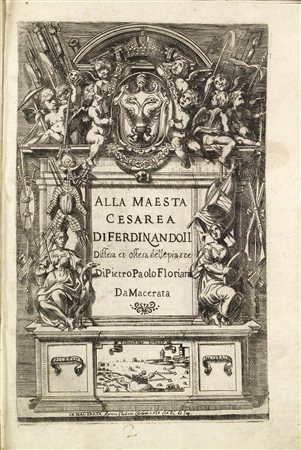 Itineris Casa d'Aste - Via Tiziano Vecellio 34/D, 10126 Torino
Itineris Casa d'Aste - Via Tiziano Vecellio 34/D, 10126 Torino
DIPINTI E SCULTURE ANTICHI E DEL XIX SECOLO - LIBRI ANTICHI - STAMPE E DISEGNI Prima Sessione - Libri antichi, disegni e stampe
giovedì 18 giugno 2020 ore 15:00 (UTC +01:00)
Pietro Paolo Floriani (1585 - 1638) Diffesa et offesa delle piazze. In...
Pietro Paolo Floriani (1585 - 1638)
Diffesa et offesa delle piazze. In Macerata: apresso Giuliano Carboni, 1630.
In-folio (mm 310x216). Pag. 8, 213 (i.e. 218), (32). Legatura in mezza pergamena del 20° secolo. Bellissimo frontespizio inciso in rame alle armi del Dedicatario Ferdinando II, 1 ritratto dell'Autore a piena pagina entro elaborata cornice architettonica inciso da Franciscus Pellegrinus Anconitanus (datato 1628) e 52 tavole numerate 1-50 di cui 43 a piena pagina fuori testo e 1 piω volte ripiegata in fine. Errori nella numerazione e nella segnatura dei fascicoli, indicati al colophon, ma esemplare ben completo e in ottimo stato di conservazione.
Rara prima edizione di una delle poche opere standard italiane del 17 ° secolo sulla costruzione di fortezze. L'architetto militare PP Floriani (1584-1638), originario di Macerata, fu inviato a Malta da papa Urbano VIII nel 1634 dopo aver lavorato in Spagna, Algeria, Austria, Ungheria, Praga e Bratislava come ufficiale e ingegnere militare Sono state coinvolte fortificazioni. Da questo libro di fortificazioni riccamente illustrato, una seconda edizione (molto piω frequente) fu pubblicata a Venezia nel 1654 e infine una terza a Londra nel 1725. - (Pochi piatti dorati, foxing minimo in alcuni punti). - Nel complesso una copia molto buona e completa di questa rarità. Prima edizione molto scarsa di questa enciclopedia illustrata di tutte le parti e gli strumenti di fortificazione, una delle poche opere standard italiane sull'argomento pubblicata nel 17 ° secolo. P. P. Floriani (1584-1638) di Macerata era un ingegnere impiegato da papa Urabnus VIII. Quando Floriani ispezionò il fronte di La Valletta, scrisse che questi non potevano essere adattati alla guerra di artiglieria prevalente a quel tempo. La guerra stava cambiando e l'artiglieria veniva sempre piω utilizzata. Una seconda edizione di questo importante libro fu pubblicata a Venezia nel 1654, una terza a Londra nel 1725.
Cfr. Cockle 825a. - Graesse II, 602; Pohler III, 695; Solo 1 copia nella NUC (Newberry Library, Chicago).
In-folio (mm 310x216). 8, 213 (i.e. 218), (32) pp. Half parchment binding of the 20th century. Beautiful copper titlepage engraved in the arms of Dedicatario Ferdinando II, 1 full-page portrait of the author within elaborate architectural frame engraved by Franciscus Pellegrinus Anconitanus (dated 1628) and 52 numbered plates 1-50 of which 43 full-page out of text and 1 folded several times at the end. Mistakes in the numbering and in the signature of the files, indicated in the colophon, but a very complete and in excellent condition copy.
Rare first edition of one of the few standard Italian works of the 17th century on the construction of fortresses. The military architect PP Floriani (1584-1638), originally from Macerata, was sent to Malta by Pope Urban VIII in 1634 after working in Spain, Algeria, Austria, Hungary, Prague and Bratislava as an officer and military engineer. Fortifications were involved . From this richly illustrated book of fortifications, a second (much more frequent) edition was published in Venice in 1654 and finally a third in London in 1725. - (Few golden plates, minimal foxing in some places). - Overall a very good and complete copy of this rarity. Very poor first edition of this illustrated encyclopedia of all parts and fortification tools, one of the few standard Italian works on the subject published in the 17th century. P. P. Floriani (1584-1638) from Macerata was an engineer employed by Pope Urabnus VIII. When Floriani inspected the Valletta front, he wrote that these could not be adapted to the artillery war prevailing at the time. The war was changing and artillery was being used more and more. A second edition of this important book was published in Venice in 1654, a third in London in 1725.
Cf. Cockle 825a. - Graesse II, 602; Pohler III, 695; Solo 1 copia nella NUC (Newberry Library, Chicago).






